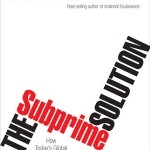I am an admitted follower of the work of economist Dr. Robert J. Shiller.
His partial bio reads like this (From Yale University): Robert J. Shiller is the Arthur M. Okun Professor of Economics, Department of Economics and Cowles Foundation for Research in Economics, Yale University, and Professor of Finance and Fellow at the International Center for Finance, Yale School of Management. He received his B.A. from the University of Michigan in 1967 and his Ph.D. in economics from the Massachusetts Institute of Technology in 1972. He has written on financial markets, financial innovation, behavioral economics, macroeconomics, real estate, statistical methods, and on public attitudes, opinions, and moral judgments regarding markets. There is much more to his bio here.
I finally got around to reading Subprime Solutions – How Today’s Financial Crisis Happened and What to do about it. (Princeton University Press, Princeton, New Jersey USA Copyright (c) 2008 by Robert J. Shiller
Admittedly, Shiller’s other recent books entitled Irrational Exuberance (2005) and Animal Spirits (with George Akerlof – 2009) are terribly tough acts to be compared against. My review of Animal Spirits is here. I am devouring Irrational Exuberance at the moment.
I enjoyed this book yet, found many of the proposed solutions (continual workout mortgage, equity insurance for homeowners etc.) lacking in their application to the new dimensions of the U.S. homeowner crisis that now exist, in 2010.
Yet, Shiller always has insights that I find appetizing. I always learn from his work. Clearly he remains both a central and highly regarded advocate for the “unfinished business” that U.S. policy makers must embrace to thwart the ongoing loss of home ownership by the American middle-class and establish safeguards to this will not happen again.
Here are some excerpts from Subprime solutions that I really appreciated. I’ll let Shiller’s words speak for themselves:
“More importantly, this crisis has set in motion fundamental societal changes-changes that affect our consumer habits, our values, our relatedness to each other. From now on we will all be conducting our lives and doing business with each other a little bit differently.” P.1.
“Allowing these destructive changes to proceed un impeded could cause damage not only to the economy but to the social fabric – the trust and optimism people feel for each other and for their shared institutions and ways of life – for decades to come.” P.2
“Today the typical household has as its principal investment its home. A home represents a highly leveraged exposure to a single, stationary plot of real estate-about the riskiest asset one can imagine. The standard mortgage provides no protection against difficulties in repaying the lender due to changes in the marketplace. But mortgages can and should be designed to compensate for these changes by including provisions to ensure homeowners against their major risk.” P. 22.
“strengthen the social fabric, and create the conditions for greater economic stability and growth.” P. 22
“Real home prices for the United States as a whole increased 85% between 1997 and the peak in 2006.” p 32
“The most important single element to be reckoned with in understanding this or any other speculative boom is the social contagion of boom thinking, mediated by the common observation of rapidly rising prices. This social contagion lends increasing credibility to stories – I call them “new era” stories-that appear to justify the belief that the boom will continue.” P. 41.
“He (Greenspan) does not seem to respect research approaches from the fields of psychology or sociology.” P.43
“What seems to be absent from the thinking of many economists and economic commentators is an understanding that contagion of ideas is consistently a factor in human affairs.” P.43
“The losers are disproportionately those people who have prudently been staying out of the housing market bubble.” Pp.92-93.
Religion and response to the Depression – “Even religious thinking returned to more traditional forms. The public amusement at religious foibles so evident at the time of the 1925 Scopes trial, when the Bible was put on trial versus the theory of evolution, was fading, and being replaced by a desire to find in religion some comforting interpretation of life.” pp. 96-97
“We must always be concerned about public perceptions of fairness and evenhanded treatment, about public confidence that our economic system is moving forward to provide opportunities for all. That confidence is being seriously eroded in today’s subprime crisis.” P.100.
“The loss of trust and belief in the economic system can have consequences not only for the economy itself, but for the social fabric as a whole, leading us all to suffer needlessly. P. 101
“The balance sheet problems into which people fall if their homes lose value are purely financial losses. But they can be converted into substantial real losses to the economy if they are allowed to destroy public confidence.” P.105 –
“There is an inherent unfairness in our economy, evidenced by its sharp income inequalities.” P.106
“We have to be willing to spend money on securing economic justice. That means allocating resources to determining-to the extent that this is possible-who among mortgage borrowers were misled and mistreated, and then focusing the bailouts on them.” P. 112
“In a similar vein, the human sciences- psychology, sociology, anthropology, and neurobiology-are increasing our understanding of the mind by leaps and bounds, and this knowledge is now being applied to finance and economics. We have a much better grasp of how and why people make economic errors, and of how we can restructure institutions to help avoid these errors. Pp. 118-119
“Denying the importance of psychology and other social sciences for financial theory would be analogous to physicists denying the importance of friction in the application of Newtonian mechanics.” P. 119
“A new kind of home mortgage that I call a continuous-workout mortgage would have terms that are adjusted continuously (in practice probably monthly) in response to evidence about changing ability to pay and changing conditions in the housing market.” P. 157
“Decreases in home values can reduce or even eliminate a homeowner’s equity, making it difficult or impossible for the owner to refinance with a new mortgage. The homeowner may conclude that it is impossible to move to another home, even if such a move would allow her to take advantage of a lucrative job offer. The mortgage .I’ may eventually end in default, especially since the homeowner may decide that it is just not worth struggling to make further payments on a mortgage when she can just walk away from the whole mess.” P. 161
“Louis Uchitelle, in his 2007 book The Disposable American: Layoffs and Their Consequences, discovered that those on whom this misfortune falls are truly suffering –but suffering mostly in silence, out of a sense of shame and of being at fault.” P. 164
“Risk-avoidance behavior also has an impact on the behavior of city, regional, and even national governments. Fearing the uncertainties associated with new economic development initiatives, these governments typically choose to play it safe and model themselves along conventional lines. They slavishly imitate other successful entities when they ought to be cultivating their locales as vital centers for specific emerging technologies or industries.” P. 168 –
“The key to long – term economic success is rightly placed confidence in markets. In contrast, bubbles are the result of misplaced confidence.” P. 171.
A great read written to be consumed by a broad audience. I recommend it.




